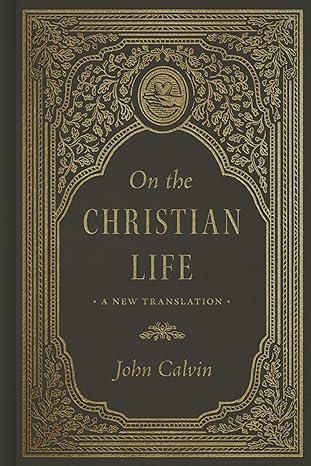A Book Review from Books At a Glance
by Michael D. Mock
In considering my remarks for reviewing this book by John Calvin, I half-entertained my only words being, “It’s John Calvin. Read it.” As you see, there is more to the review than that. However, Calvin’s godly reputation precedes him. He was one of the best students and teachers of the Word of God, and whatever he wrote is always worth reading and considering. I do not say this only as a student of Calvin, but also as a student of theology: Prioritize Calvin’s works over everyone else’s (except for Scripture, of course!). Nevertheless, the interested potential reader may have some questions or objections to picking this up and reading it.
Length
There really is no objection to reading this book based on length. No one is asking the reader to devote himself to 1,000 pages of Calvin’s Institutes, which, in my estimation, would only bless the reader! But this work is a small selection of Calvin’s Institutes, only five chapters, only 60 pages. This work is an excellent gateway to Calvin. The book is short. With short sections and sub-sections, the reader can take five or ten minutes at a sitting, and he will have enough to chew on for the day. This book, and its earlier sibling by a different publisher, A Little Book on the Christian Life (by Reformation Trust) has been my go-to recommendation for those who want to begin reading Calvin. Yes, Calvin is worth reading, and this book demonstrates that worth from start to finish.
Newness
If you, however, are already aware of the other book mentioned above, you may reasonably ask why another book is published. When, for instance, we compare A Little Book on the Christian Life with On the Christian Life: A New Translation, the differences in translation are not strikingly different. Both are readable, both are contemporary, and both are accurate. Honestly, you can’t go wrong with either publication. I do prefer this newer translation work, however, and for several reasons. First, the book is more aesthetically pleasing than A Little Book. It’s a hardcover and more durable. Second, the artwork on its cover is beautiful. It even includes Calvin’s own drawing (with heart in hand), minus his personal motto. Third, by comparing some of the lines between this work and A Little Book, this publication is slightly more readable. Fourth, the translators and editor added section and sub-section summaries that really help the reader follow along or find references. Fifth, the footnote work is quite helpful without being a distraction. Finally, this publication “is a foretaste of the forthcoming new translation of Calvin’s Institutes, several years in the making, to be published by Crossway” (xiii). For anyone who would be interested in getting the one-day new translation, this book will help in considering whether or not it would be worth the purchase. Some of us may be content with the Beveridge edition, though I doubt it. Others would be satisfied with the two-volume McNeill edition, but, I doubt this as well. Students and scholars of Calvin want more and more of the population to read Calvin, and if this publication is an accurate picture of the future work, everyone will be well served by getting it.
Usefulness
Again, Calvin’s Institutes is good as a whole 4-book systematic theology and should be consulted as a whole. However, there is a reason Crossway pulled these five chapters from Book 3 of his Institutes to put before readers before publishing the rest of the work. I would not go so far as to say that it is Calvin at his finest, but we definitely see Calvin as pastor to a people who desire to follow Christ. This short section, therefore, is useful on its own as a way to frame the Christian’s life. In Chapter 6, Calvin puts before us arguments from the Bible that encourage us to a life that follows Christ wherever Jesus will take us. This is vital, because this life, as Calvin explores in Chapter 7, is one of self-denial. Calvin explains what this means for the Christian, and even how essential it is to deny the self. In Chapter 8, Calvin focuses on cross-bearing as an aspect of self-denial: entirely disagreeable to the eye of sight but wholly pleasing to the eye of faith. In Chapter 9, Calvin broadens our sight by reminding us that this life is not all that is and that our present meditation on our future life will help us to view our present suffering. In Chapter 10, Calvin balances the rejection of this world with the reception of God’s goods on the earth. We are not, in other words, to adopt a monastic style of living, but neither do we adopt the view that this life is our best life now.
This book is an excellent introduction to Calvin and an encouraging guide to the Christian who wants to learn to follow Christ more and more with his moments and his days. I have led some church members through A Little Book as I have discipled some one-on-one. And now, I will do the same, but with On the Christian Life: A New Translation. So, Christian, it’s John Calvin. Read it.
Michael D. Mock
